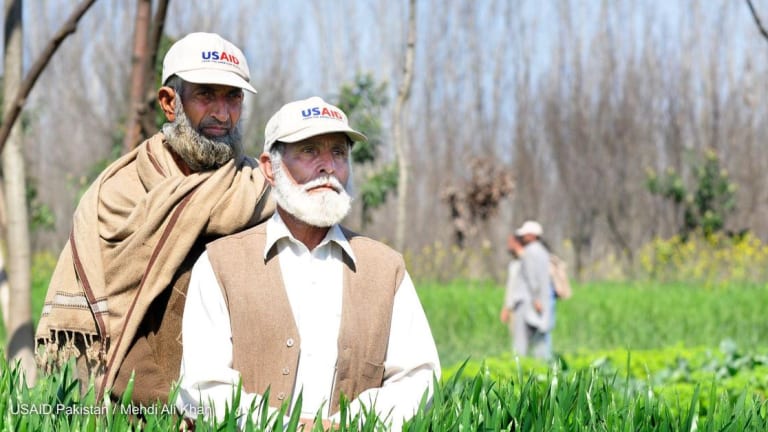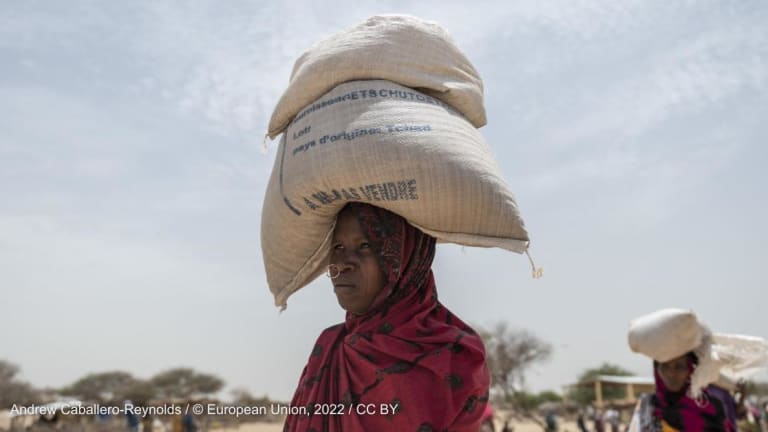What is happening with USAID's business forecasts?
The United States Agency for International Development is already planning for life under the Trump administration with anticipated budget reductions, consolidated programs and investments that focus on crisis and conflict-related programs. Quarter three of the agency's business forecast data provides clues as to how those plans might look.
Quarter three of the United States Agency for International Development’s business forecast data provides the first real insight into what a USAID under a Trump administration may look like. Looking beyond the current budget cycle, forecast project changes made since the quarter two release were presented by USAID on Tuesday as part of their quarterly business forecast review call, along with a range of new measures USAID are making to open opportunities for businesses to better engage with the aid program. Devex analyzed the new quarter of data to identify changes and trends since quarter two through our interactive Tableau visualization, which provides insights for current and potential aid program partners on projects expected to be available for tendering or grants. USAID is already planning for anticipated budget reductions, consolidated programs, and investments that focus on crisis and conflict-related programs. The forecast business data might give a hint as to how those plans might look. Here are some of the insights from our analysis of the data. Making a mark In quarter two of the business forecast, 248 awards were in the pipeline. As of Tuesday, there were 199 active awards with a number having moved out of the early-stage project to the tendering phase. But 166 of the awards in the database had been carried over from the previous quarter with most maintaining the same budget, eight with an increased budget and 24 with forecast cuts. Through the alterations to the projected expenditure on partner programs, the data shows a potential reduction of between $257 million and $594 million to the aid program based on the expenditure range USAID assigns to their indicative program budgets. The shifting budget sands and newly listed business opportunities show a USAID that is beginning to deliver a program reflecting the new administration's goals for foreign aid. Recipient country and region trends Recipient country and region trends provide additional insights into the new administration’s goals. Canceled and reduced programs will have the largest impact on Kenya. Two programs targeting food security for the African nation will continue, but in a reduced format thanks to a budget reduction of $183 million. Afghanistan will be impacted by a reduction of $78 million in the area of agriculture and food security and economic growth and trade. But despite this, both Afghanistan and Kenya are predicted to receive almost $300 million each from forecast awards, just behind Mozambique, which will receive an estimated $400 million for a single program supporting efficiencies for clinical HIV outcomes anticipated to be awarded in Oct. 2018. Peru has the highest number of business opportunities by region with eight awards on the horizon — all with an environmental focus but a combination of bilateral and regional projects, according to USAID. In supporting delivery of global programs, the Office of Land Tenure and Resource Management within USAID will see their budget impacted by forecast reduction of $62 million, which were targeted for global environmental programs. But the Bureau for Democracy, Conflict and Humanitarian Assistance will be one of the most important areas for USAID to deliver the quarter three business opportunities forecast; they are the implementing office for $2.8 billion worth of awards. The Office of Health Infectious Diseases and Nutrition follows with $1.5 billion of awards to manage. Sector trends Among the projects that have had reduced budget forecasts or been canceled between quarters, one-third of projects are in economic growth and trade, while approximately 40 percent of the budget reduction ($226 million) is in projects related to agriculture and food. One canceled agriculture and food program and commercialization partnerships for greater private sector engagements are surprise cuts as USAID informed business partners they are considering its options and its future with these types of activities. And as President Trump considers options for the U.S. under the Paris Agreement on climate change, $113.5 million has been reduced from environmental and global climate change programs. These include climate change and clean energy programs for Cambodia, Colombia and El Salvador. In the new quarter of data, U.S. global development labs and projects supporting gender equality and women’s empowerment received the smallest investment of aid through new business opportunities. And despite heavy losses of funding to support women in developing countries through the re-introduction of the “global gag rule,” there have been no new programs investing in gender through the business forecast opportunities. Global health programs continue to dominate spending opportunities with 43 forecast awards with an estimated value of $3.3 billion. Forty-one opportunities are available for awards associated with democracy, human rights and governance while programs associated with crises and conflict will be worth nearly $2.5 million — with a single contributing more than 90 percent of the investment in this sector. New award highlights The fifth iteration of the Support Which Implements Fast Transitions (SWIFT) program, which provides fast and short-term assistance to countries in transition to advance peace and democracy, was the largest new investment of funds contributing to growth in the crisis and conflict sector. SWIFT V is expected to receive between $2 billion and $2.5 billion over the next five years. The program team for SWIFT consists of staff from the Office of Transition Initiatives, an area of USAID that supports foreign policy objectives through the funding of local partners within developing countries, and contractor personnel. The previous round for the SWIFT program included U.S. based partners AECOM, Casals and Associates, Chemonics International, Creative Associates International, DAI, International Relief and Development, Management Systems International and RTI International in the delivery of programs under the scheme. A similar approach is expected. The scheme makes the Bureau for Democracy, Conflict and Humanitarian Assistance and OTI within it one of the most confident areas of USAID in retaining programs and staff under the new administration. Other new opportunities to be aware of is a combined total of $225 million expected to be awarded for each of the following programs supporting jobs creation in Afghanistan, expanding use of blended finance solutions to support USAID priorities and malaria surveillance project for Tanzania. Consolidating projects In total, there are 45 fewer awards forecast between quarters two and three and with a number listed as cancellations. This may suggest a direction toward consolidating programs — reduced or consolidated programs can mean less costs for administering the aid program and is a strategy that is being used elsewhere, including in Australia’s aid program. The trend for consolidation is most evident with programs and funding within the Center for Accelerating Innovation and Impact, which enables USAID to invest in innovative health approaches and accelerate them from the lab to on-the-ground, practical solutions. Between quarters, the number of programs forecast for the center declined from 13 to just one — 12 projects targeted for round seven of the Saving Lives at Birth Grand Challenge have been removed from the forecast with no announcement on the seventh round of funding, which closed in February. But despite this decline, the center has received an increase in total funding averaging $115,000. The new program aims to increase the impact of global health initiatives through human design centered services. Preparing for changes to USAID business opportunities A recent analysis by Devex into the top USAID contractors for 2016 reveals a 5 percent drop in contract funding from 2015. The new business forecasts may suggests that in 2017 the downward trend will continue. For the smaller players vying for aid funding, the big contracts will mean competing against large-scale players such as Chemonics International. But the USAID business forecast will provide opportunities solely for small business, women-led organizations or other sectors often overlooked in government tendering. New features in the business forecast site will also provide businesses with email contact details of personnel associated with forecasted projects — enabling early engagement with key staff to understand aid requirements in preparing a bid. And daily updates to the forecasts mean businesses no longer need to wait three months to find out what is on the horizon. But be warned: there is a lot of new competition for USAID opportunities. Since the business forecasts were updated to daily feeds, the site has received more than 170,000 hits over the past three months, almost tripling statistics on site usage from 12 months ago. Devex has you covered with all the USAID Business Forecast real-time updates through the Funding Activity Feed, which is also accessible through this interactive visualization that compares the past two USAID Business Forecasts. For more insights, interact with our USAID business forecast visualization.
Quarter three of the United States Agency for International Development’s business forecast data provides the first real insight into what a USAID under a Trump administration may look like. Looking beyond the current budget cycle, forecast project changes made since the quarter two release were presented by USAID on Tuesday as part of their quarterly business forecast review call, along with a range of new measures USAID are making to open opportunities for businesses to better engage with the aid program.
Devex analyzed the new quarter of data to identify changes and trends since quarter two through our interactive Tableau visualization, which provides insights for current and potential aid program partners on projects expected to be available for tendering or grants.
USAID is already planning for anticipated budget reductions, consolidated programs, and investments that focus on crisis and conflict-related programs. The forecast business data might give a hint as to how those plans might look.
This story is forDevex Promembers
Unlock this story now with a 15-day free trial of Devex Pro.
With a Devex Pro subscription you'll get access to deeper analysis and exclusive insights from our reporters and analysts.
Start my free trialRequest a group subscription Printing articles to share with others is a breach of our terms and conditions and copyright policy. Please use the sharing options on the left side of the article. Devex Pro members may share up to 10 articles per month using the Pro share tool ( ).
Lisa Cornish is a former Devex Senior Reporter based in Canberra, where she focuses on the Australian aid community. Lisa has worked with News Corp Australia as a data journalist and has been published throughout Australia in the Daily Telegraph in Melbourne, Herald Sun in Melbourne, Courier-Mail in Brisbane, and online through news.com.au. Lisa additionally consults with Australian government providing data analytics, reporting and visualization services.
Arnau Rovira is the knowledge management lead at Devex’s Analytics implementing information management solutions to the different data needs of the organization. He works remotely from Burundi. Previously, he worked in data collection management in Manila and as business intelligence analyst at Scytl, worldwide leader on electoral voting solutions. In his interest to the international and electoral affairs, he became an electoral observer. Until now, he has been deployed in Uruguay, Ukraine and Bosnia and Herzegovina.





